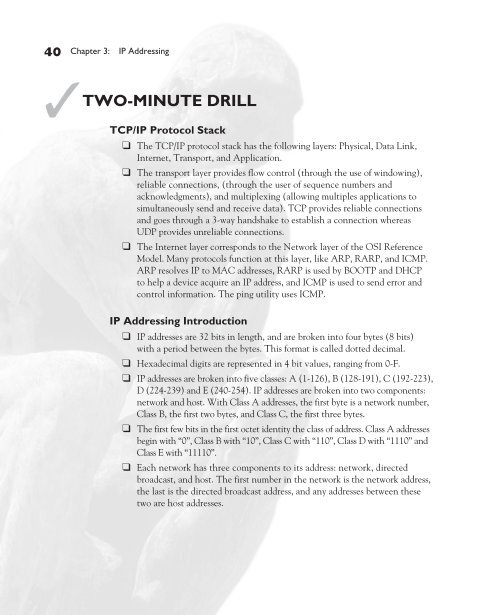ch03 IP Addressing.pdf - The Cisco Learning Network
ch03 IP Addressing.pdf - The Cisco Learning Network
ch03 IP Addressing.pdf - The Cisco Learning Network
Create successful ePaper yourself
Turn your PDF publications into a flip-book with our unique Google optimized e-Paper software.
40 Chapter 3: <strong>IP</strong> <strong>Addressing</strong><br />
✓TWO-MINUTE DRILL<br />
TCP/<strong>IP</strong> Protocol Stack<br />
❑ <strong>The</strong> TCP/<strong>IP</strong> protocol stack has the following layers: Physical, Data Link,<br />
Internet, Transport, and Application.<br />
❑ <strong>The</strong> transport layer provides flow control (through the use of windowing),<br />
reliable connections, (through the user of sequence numbers and<br />
acknowledgments), and multiplexing (allowing multiples applications to<br />
simultaneously send and receive data). TCP provides reliable connections<br />
and goes through a 3-way handshake to establish a connection whereas<br />
UDP provides unreliable connections.<br />
❑ <strong>The</strong> Internet layer corresponds to the <strong>Network</strong> layer of the OSI Reference<br />
Model. Many protocols function at this layer, like ARP, RARP, and ICMP.<br />
ARP resolves <strong>IP</strong> to MAC addresses, RARP is used by BOOTP and DHCP<br />
to help a device acquire an <strong>IP</strong> address, and ICMP is used to send error and<br />
control information. <strong>The</strong> ping utility uses ICMP.<br />
<strong>IP</strong> <strong>Addressing</strong> Introduction<br />
❑ <strong>IP</strong> addresses are 32 bits in length, and are broken into four bytes (8 bits)<br />
with a period between the bytes. This format is called dotted decimal.<br />
❑ Hexadecimal digits are represented in 4 bit values, ranging from 0-F.<br />
❑ <strong>IP</strong> addresses are broken into five classes: A (1-126), B (128-191), C (192-223),<br />
D (224-239) and E (240-254). <strong>IP</strong> addresses are broken into two components:<br />
network and host. With Class A addresses, the first byte is a network number,<br />
Class B, the first two bytes, and Class C, the first three bytes.<br />
❑ <strong>The</strong> first few bits in the first octet identity the class of address. Class A addresses<br />
begin with “0”, Class B with “10”, Class C with “110”, Class D with “1110” and<br />
Class E with “11110”.<br />
❑ Each network has three components to its address: network, directed<br />
broadcast, and host. <strong>The</strong> first number in the network is the network address,<br />
the last is the directed broadcast address, and any addresses between these<br />
two are host addresses.

















